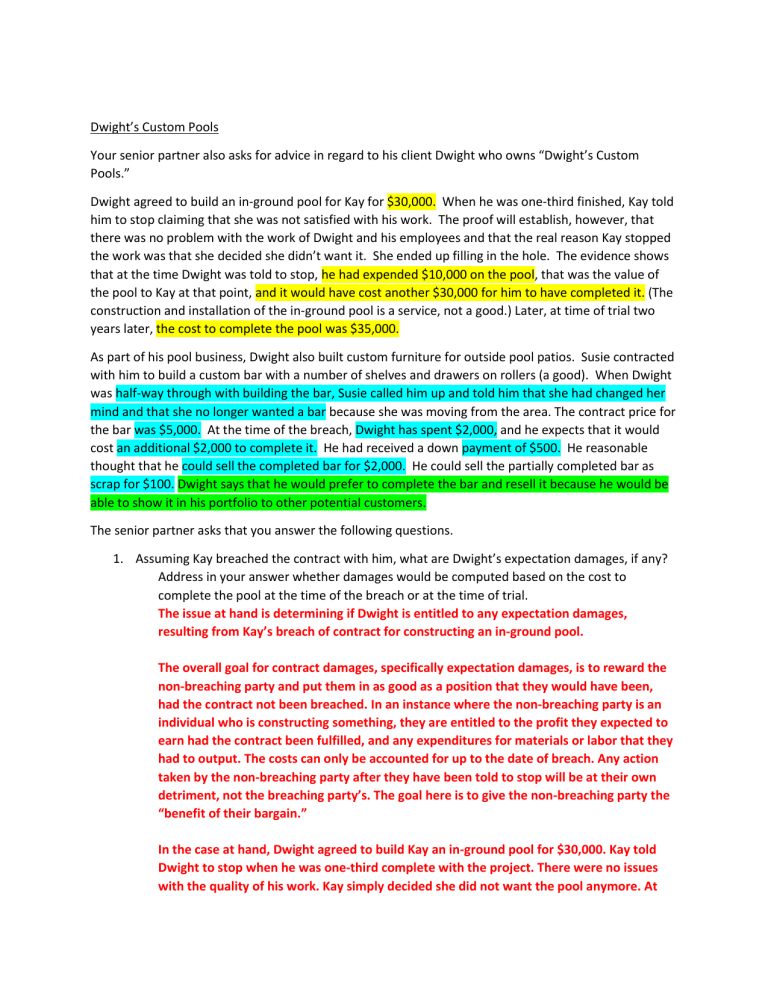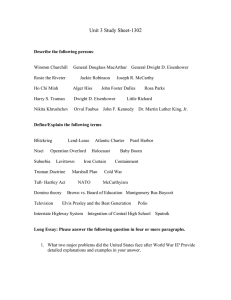
Dwight’s Custom Pools Your senior partner also asks for advice in regard to his client Dwight who owns “Dwight’s Custom Pools.” Dwight agreed to build an in-ground pool for Kay for $30,000. When he was one-third finished, Kay told him to stop claiming that she was not satisfied with his work. The proof will establish, however, that there was no problem with the work of Dwight and his employees and that the real reason Kay stopped the work was that she decided she didn’t want it. She ended up filling in the hole. The evidence shows that at the time Dwight was told to stop, he had expended $10,000 on the pool, that was the value of the pool to Kay at that point, and it would have cost another $30,000 for him to have completed it. (The construction and installation of the in-ground pool is a service, not a good.) Later, at time of trial two years later, the cost to complete the pool was $35,000. As part of his pool business, Dwight also built custom furniture for outside pool patios. Susie contracted with him to build a custom bar with a number of shelves and drawers on rollers (a good). When Dwight was half-way through with building the bar, Susie called him up and told him that she had changed her mind and that she no longer wanted a bar because she was moving from the area. The contract price for the bar was $5,000. At the time of the breach, Dwight has spent $2,000, and he expects that it would cost an additional $2,000 to complete it. He had received a down payment of $500. He reasonable thought that he could sell the completed bar for $2,000. He could sell the partially completed bar as scrap for $100. Dwight says that he would prefer to complete the bar and resell it because he would be able to show it in his portfolio to other potential customers. The senior partner asks that you answer the following questions. 1. Assuming Kay breached the contract with him, what are Dwight’s expectation damages, if any? Address in your answer whether damages would be computed based on the cost to complete the pool at the time of the breach or at the time of trial. The issue at hand is determining if Dwight is entitled to any expectation damages, resulting from Kay’s breach of contract for constructing an in-ground pool. The overall goal for contract damages, specifically expectation damages, is to reward the non-breaching party and put them in as good as a position that they would have been, had the contract not been breached. In an instance where the non-breaching party is an individual who is constructing something, they are entitled to the profit they expected to earn had the contract been fulfilled, and any expenditures for materials or labor that they had to output. The costs can only be accounted for up to the date of breach. Any action taken by the non-breaching party after they have been told to stop will be at their own detriment, not the breaching party’s. The goal here is to give the non-breaching party the “benefit of their bargain.” In the case at hand, Dwight agreed to build Kay an in-ground pool for $30,000. Kay told Dwight to stop when he was one-third complete with the project. There were no issues with the quality of his work. Kay simply decided she did not want the pool anymore. At the point of breach, it would have costed Dwight an additional $30,000 to complete the pool, on top of his already expended $10,000. Dwight must have miscalculated the cost of the project. If he would have completed it, he would have expended $40,000 and only received the agreed upon $30,000 from Kay. That would put him at incurring $10,000 to his own detriment at the time of breach. Therefore, he would be entitled to 0 dollars in expectation damages to put him in the same place as if the contract had been completed. This is due to not having correct calculations, which is not Kay’s fault. But if the damages are computed based on the time of trial, he would receive 0 dollars in expectation damages. That is based on the current market value of $35,000 to complete the pool, on top of his $10,000 that has already been expended. He will be in debt $15,000 due to his own miscalculations for the contract price. He does not have any options to mitigate or any profits to rely on for damages. 2. Assuming Kay breached the contract with him, what are Dwight’s reliance damages, if any? The issue here is to determine what the amount of reliance damages should be awarded to Dwight. The goal of reliance damages is to put the non-breaching party in as good of a position that they would have been had the contract never been formed. These types of damages are utilized when expectation damages are too speculative or offend public policy. The amount in reliance damages is not allowed to exceed the original, full contract price. Reliance damages are based on the non-breaching party’s reliance interest, plus any expenditures made in preparation or performance of the contract. Any loss that the breaching party can prove, with reasonable certainty, that the non-breaching party would have endured regardless the breach, will not be included in the reliance damages amount. Because Dwight miscalculated the amount to construct, complete, and profit off of this agreement he will be in debt. He is not entitled to any reliance damages because he would not have profited of this contract. Typically, he would be entitled to enough reliance damages to make him “break even.” That amount would be $10,000 at the time of the contract agreement and upon completion. The other amount, based on at the time of trial would be $15,000 due to the increase in market pricing. Kay could prove Dwight would have lost profits to begin with, therefore he would not be entitled to reliance damages. 3. What advice should the senior partner give Dwight regarding Susie as to whether Dwight should stop now or finish and resell the furniture? Include in your answer the applicable legal standard as well as what his damages would be if he stopped now and what his damages would be if he completed the bar. Dwight has two options that he may choose from when dealing with the breach of contract, caused by Susie. He can either stop and sell what he has for scrap or finish the project and resell it. Either way Dwight MUST mitigate his damages in any way possible. The contract price for this project was $5,000. Dwight has already spent $2,000 for what is partially complete and expects it would take an additional $2,000 to complete. That would put him at a $1,000 expected profit. Additionally, he has received $500 as a down payment. Dwight could be entitled to expectancy damages of $2,400. ($5k-$2k-$500-$100=$2,400) This would put him in as good of a place had the contract been completed. This is based on the amount it would take to complete the whole contract minus his expected profit. (5k-1k) Then taking what he has already expended and what he could salvage the scrap for, along with the down payment. Reliance damages would be utilized to put Dwight in the same position he would have been had the K never been formed. To calculate this, you add up what he has been paid and what he can mitigate ($600) and the amount he has expended ($2,000) and that gives you $1,400 in reliance damages. If Dwight were to finish the project, it would take $2,000 more dollars, making his total expenditure $4,000. He has already been paid $500 dollars as a down payment. Making his total expenditure $3,500. He can reasonably sell the project, completed, for $2,000. Meaning he would be in the hole $1,500 due to loss profits. Therefore, I would advise Dwight to pursue damages claim against Susie. By doing so, he would profit off of this agreement, just has he had thought.



